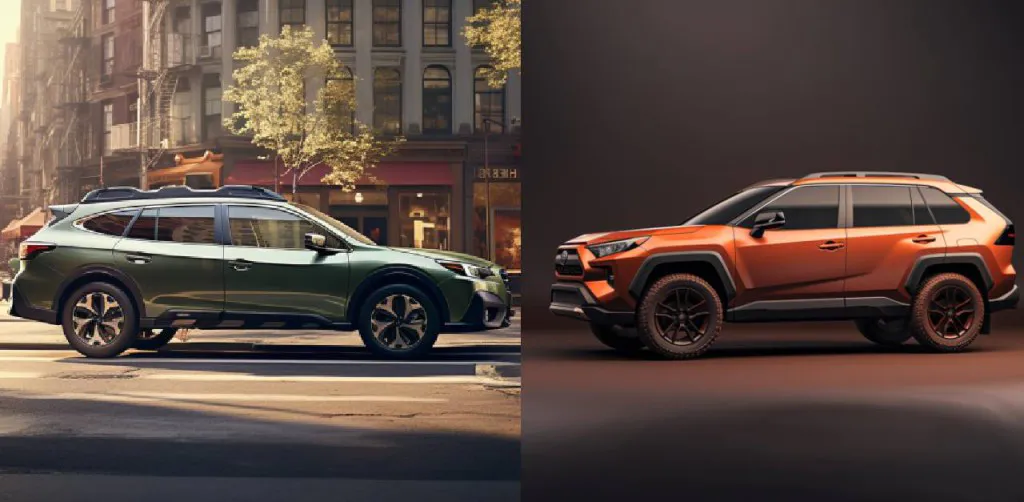The crossover marketplace has long since taken priority seating over the traditional sedan across the American automotive landscape. One of these crossovers, the Toyota RAV4, is partially credited with starting the cute-ute, or small SUV, segment back in 1995.
At the same time, another Japanese automaker, Subaru, applied the same thinking of rugged-ish styling to a car platform, and the Outback was born. Nearly 3 decades later, the Subaru Outback is one of the few (only?) remaining mainstream station wagons and it does a fine job competing in the crowded crossover arena.
To help shoppers decide which new 2023 model of the Subaru Outback and RAV4 is better for them, we’ve put together this comprehensive comparison.
Along with dimensions, features, and technology offerings, we’ll cover safety scores per the National Highway Traffic Safety Administration (NHTSA), 5-year ownership costs, and fuel economy figures from FuelEconomy.gov.
Those looking at the used market should head over to our best model year comparison of the Outback and RAV4 that analyzes objective and subjective reliability, repair costs, and more going back 20 years.
You can also read up on other segment offerings with our best and worst model year series for the Honda CR-V, Ford Edge, Nissan Murano, and Subaru Forester.
Find details about the methodology used for this comparison at the bottom of the page.
2023 Subaru Outback vs Toyota RAV4 | A Guide to Trim Levels & Optional Features
Trim Levels: Starting Prices
Quick Take: The Outback and RAV4 have nearly identical starting prices, but the Subaru gets pricier at the top of the range. However, the RAV4 goes further with hybrid and plug-in hybrid (PHEV) models.
A bit more than $28,000 will get you into a new Subaru Outback or Toyota RAV4, but the Outback ratchets up the price more quickly. In Wilderness trim, it competes with the RAV4 TRD Off-Road, but the Toyota is about $2,000 cheaper.
The top-spec Outback Touring XT runs $7,000 higher than a RAV4 Limited, but keep in mind, this Subaru model has a far more potent powertrain than its Toyota competitor as we’ll look at more closely below.
Other notable differences are the range of hybrid RAV4s available, this is a powertrain not available with the Outback. The same is true of the RAV4 Prime series, which is Toyota-speak for PHEV. These variants get expensive but offer a usable electric driving range, which we’ll cover later.
| 2023 Subaru Outback Model | Starting Price |
| Base | $28,395 |
| Premium | $31,920 |
| Onyx Edition | $34,720 |
| Onyx Edition XT | $39,820 |
| Wilderness | $39,670 |
| Limited | $36,520 |
| Limited XT | $40,920 |
| Touring | $41,070 |
| Touring XT | $43,520 |
| 2023 Toyota Rav4 | Starting Price |
| LE | $28,275 |
| XLE | $29,785 |
| XLE Premium | $32,675 |
| Adventure | $34,470 |
| TRD Off-Road | $37,895 |
| Limited | $36,580 |
| Hybrid LE | $31,225 |
| Hybrid XLE | $32,735 |
| Hybrid Woodland Edition | $34,025 |
| Hybrid XLE Premium | $35,625 |
| Hybrid SE | $33,920 |
| Hybrid XSE | $36,885 |
| Hybrid Limited | $39,530 |
| Prime SE | $43,090 |
| Prime XSE | $46,960 |
Cost of Ownership
Quick Take: You’ll pay about the same $38,000 over 5 years for a new Outback or RAV4, but the Subaru will cost you more in gas and upkeep costs.
If you plan to buy a new car, it’s important to have an idea of what you can expect the total bill to be longer term, say over 5 years. Fortunately, Edmunds provides just such information, which we’ve distilled into the table below.
The total figure is remarkably close between the Outback and RAV4 at a bit more than $38,000. These crossovers have identical cost-per-mile numbers of $0.51, while depreciation takes a bigger bite out of the RAV4.
But the RAV4’s more fuel-efficient ways make an impact on long-term gas costs and the Toyota is lighter on the wallet when it comes to upkeep and repairs versus the Outback.
| 5-Year Ownership Cost | ||
| Costs | Subaru Outback | Toyota RAV4 |
| Cost to Own | $38,390.00 | $38,479.00 |
| Average Cost Per Mile | $0.51 | $0.51 |
| Depreciation | $10,680 | $11,601 |
| Fuel | $9,704 | $9,052 |
| Maintenance | $5,399 | $4,960 |
| Repairs | $813 | $665 |
RAV4 LE 4dr SUV (2.5L 4cyl 8A)
2023 | Subaru Outback vs Toyota RAV4 | Specifications | Safety, Interior and Exterior Features
Vehicle Class & Body Style:
Quick Take: Both of these vehicles are in the midsize crossover segment, but the Subaru is quite a bit larger inside and out.
The U.S. Environmental Protection Agency (EPA) likes to apply confounding classifications to vehicles that are based on passenger volume, leaving us with what you see in the table below. However, automakers like to mix and match the terms “crossover” and “SUV”, and while Subaru’s Outback is really a station wagon – they wouldn’t dare call it as such.
What does this mean for you, the buyer? It means you need to get inside both of these vehicles to determine which is best for your particular needs. On paper, the Outback is larger than the RAV4 in nearly every dimension, but nothing beats a test drive to make the final decision.
| 2023 Subaru Outback | 2023 Toyota RAV4 | |
| Class | Midsize SUV | Crossover SUV |
| 4-Door SUV | Base, Premium, Onyx Edition, Onyx Edition XT, Wilderness, Limited, Limited XT, Touring, Touring XT | Hybrid LE, Hybrid XLE, Hybrid Woodland Edition, Hybrid XLE Premium, Hybrid SE, Hybrid XSE, Hybrid Limited LE, XLE, XLE Premium, Adventure, TRD Off-Road, Limited, LE, XLE, XLE Premium, Adventure, TRD Off-Road, Limited |
Powertrain:
Engine Options & Specifications:
Quick Take: Subaru’s only advantage in the powertrain department is the speedy turbocharged option. Both SUVs can tow the same amount, but the Toyota has a wider variety of engines and far better fuel economy.
In both cases, the base 2023 Outback and RAV4 are powered by a naturally aspirated 2.5L inline-4, but the Toyota puts out an additional 21 horsepower. This is not super relevant as neither of these setups is designed for drag racing.
However, the optional turbocharged mill in the Subaru is significantly more powerful and properly quick. Both can tow up to 3,500 pounds depending on configuration, but if it’s fuel efficiency you’re after, the 2023 RAV4 takes the cake.
Even with more power, base RAV4s have the fuel economy advantage in combined ratings over the Outback. Traditional RAV4 hybrids best the Outback by 12 mpg on the combined scale and the Prime PHEV variants offer a useful 42 miles of gas-free driving range.
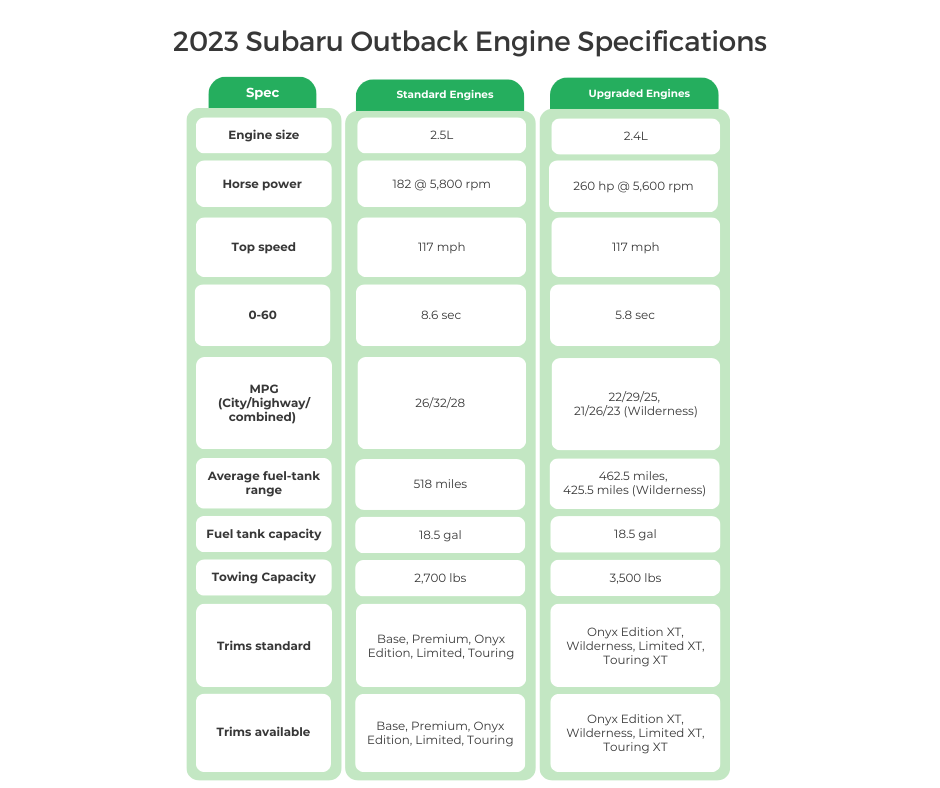
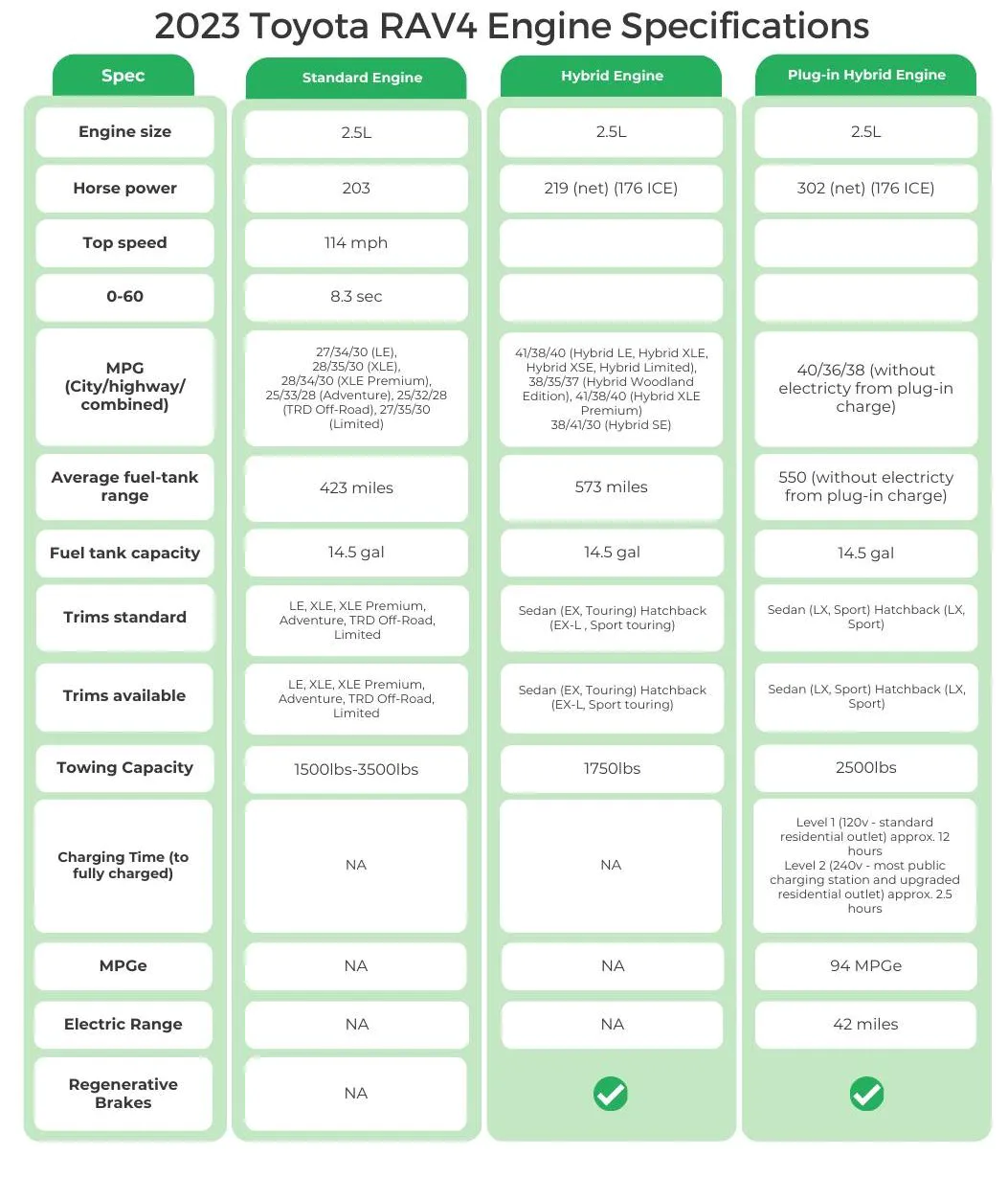
Transmission Options & Specifications:
Quick Take: If you demand the sound and feel of a conventional transmission, only the RAV4 offers one. Otherwise, it’s the moan and groan of CVTs across the Subaru and RAV4 hybrid lineups.
Subaru has been pushing continuously variable transmissions (CVT) for quite some time and the 2023 Outback follows suit with this gearless transmission as the only option. Toyota fits an electronically-controlled CVT to both hybrid models, but standard RAV4s come with a traditional 8-speed automatic.
Fancy learning more about what the deal is with all those belts and pulleys inside a CVT? Then be sure to check out the Tech Talk section below!
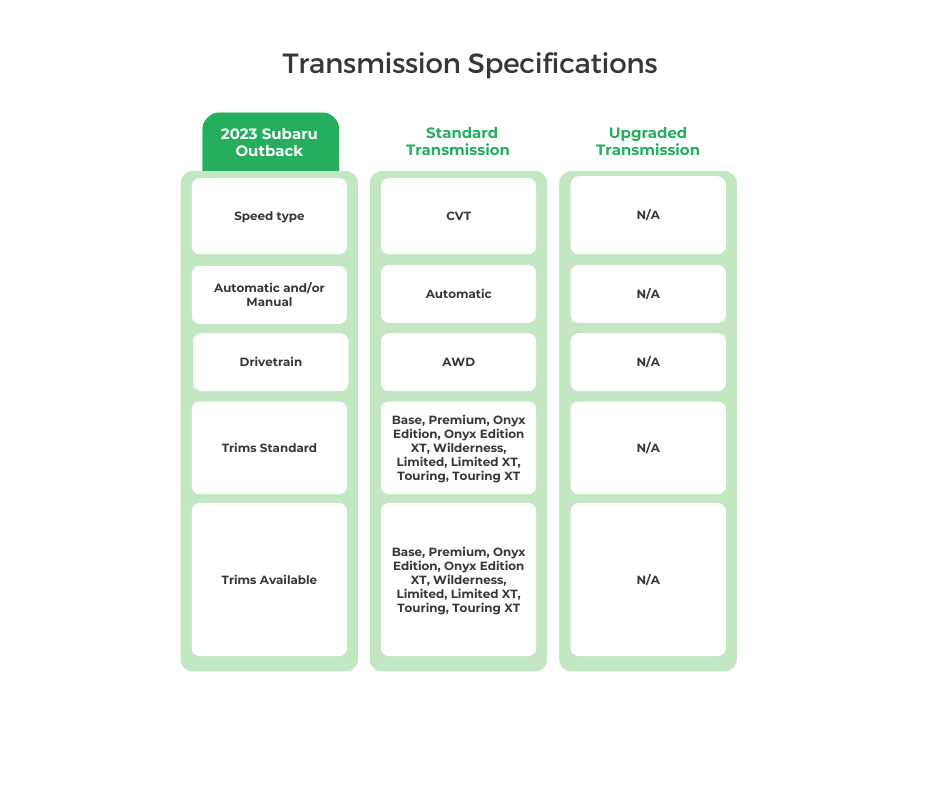
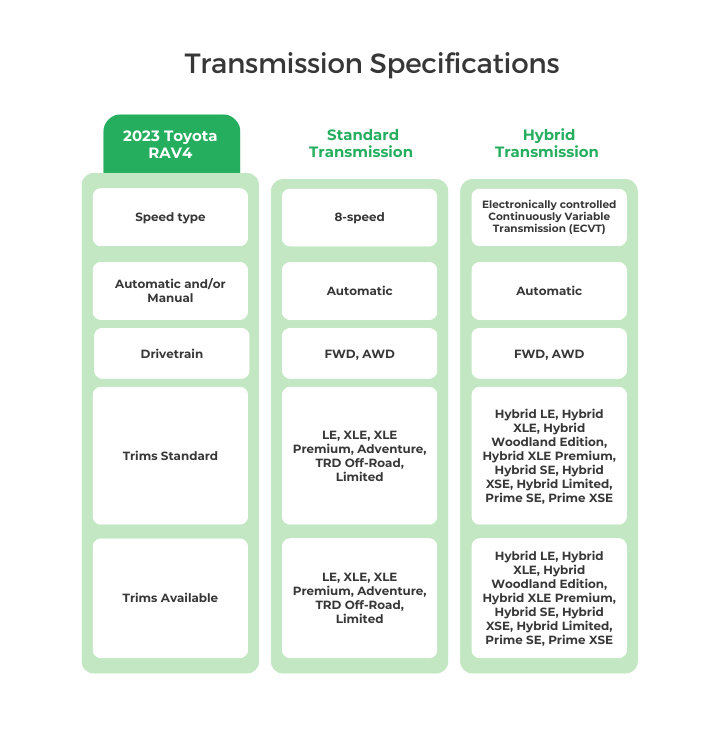
TECH TALK: CVTs
A continuously variable transmission (CVT) does not use gears like a typical automatic transmission. Instead, it has two pulleys connected by a belt. One pulley connects to the engine, and the other connects to the wheels. The belt transfers the power between the pulleys. This setup allows the pulleys to continuously change positions as needed. The CVT automatically adjusts the pulleys as required, providing smooth and efficient power delivery.
An electronic continuously variable transmission (eCVT) uses electronic controls and electric motors to vary gear ratios instead of a belt and pulley system. Unlike a regular CVT, an eCVT has no physical pulleys or belts—the gear ratio is adjusted seamlessly by controlling the speeds of electric motors and generators. This electronic control allows faster, smoother gear ratio changes compared to a traditional CVT. An eCVT also provides more flexibility, needing less space and having fewer moving parts.
Wheel Drive:
Quick Take: Both the Outback and RAV4 offer AWD, but it’s only standard on the Subaru.
One of Subaru’s main selling points for the Outback, and nearly every other model in its lineup, is standard Symmetrical All-Wheel Drive (AWD). It’s always on and is well-regarded in Snow Belt states as I can tell you from driving around the streets of wintry New Hampshire.
The Toyota RAV4 is front-wheel drive first with the option for AWD in most cases. On certain models, this AWD system has a driveline disconnect feature that mechanically cuts power to the rear wheels, as needed, to improve efficiency.
All hybrid RAV4s come with AWD, but rather than a driveshaft sending power out back, a standalone electric motor lives back there awaiting the computer’s command to start spinning the rear wheels.
| 2023 Subaru Outback Wheel Drive | FWD | AWD | RWD |
| Base | S | ||
| Premium | S | ||
| Onyx Edition | S | ||
| Onyx Edition XT | S | ||
| Wilderness | S | ||
| Limited | S | ||
| Limited XT | S | ||
| Touring | S | ||
| Touring XT | S |
U = Available in upgrade
E= electric on-demand AWD
D= AWD with rear driveline disconnect
| 2023 Toyota RAV4 Wheel Drive | FWD | AWD | RWD |
| LE | S | U | |
| XLE | S | U | |
| XLE Premium | S | U | |
| Adventure | D | ||
| TRD Off-Road | D | ||
| Limited | S | U(D) | |
| Hybrid LE | E | ||
| Hybrid XLE | E | ||
| Hybrid Woodland Edition | E | ||
| Hybrid XLE Premium | E | ||
| Hybrid SE | E | ||
| Hybrid XSE | E | ||
| Hybrid Limited | E | ||
| Prime SE | E | ||
| Prime XSE | E |
U = Available in upgrade
E= electric on-demand AWD
D= AWD with rear driveline disconnect
Safety:
Quick Take: The Subaru Outback is objectively safer per crash-testing by the NHTSA and IIHS, though the RAV4 still ranks very highly.
NHTSA Safety Ratings:
As you can see in the tables below, both the 2023 Outback and RAV4 earned a 5-star overall crash-test rating from the NHTSA. However, the Subaru gets 5 stars for frontal and side crash testing, while the Toyota comes in with a 4 for the frontal test protocol and 5 for the side test.
Both crossovers are rated 4 stars in the rollover test, though interestingly, the shorter Outback has an 18.5% chance of this happening versus 15.9% for the RAV4.
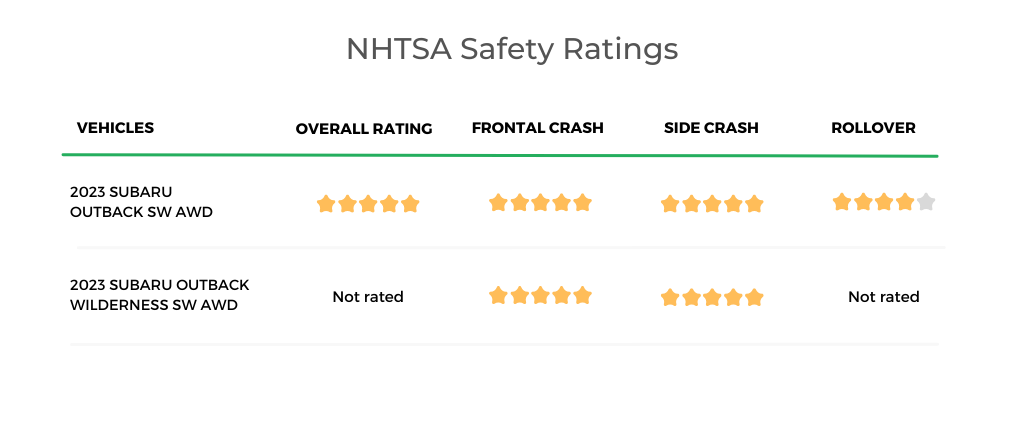
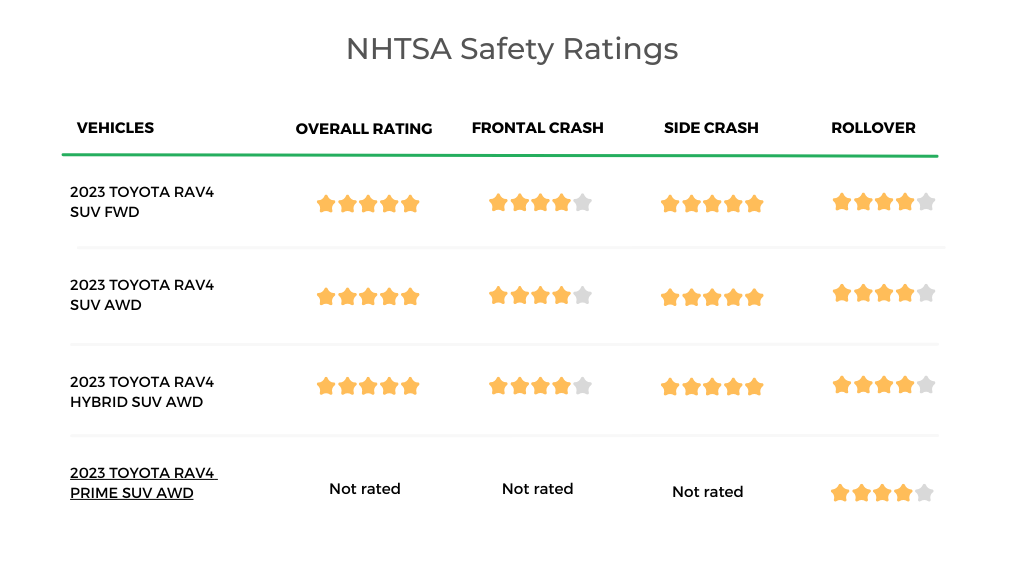
IIHS Awards:
As with NHTSA safety testing, both the Subaru Outback and Toyota RAV4 perform quite well with each vehicle earning an award, in IIHS crash testing, but the Outback performs a bit better.
Like the NHTSA, the IIHS runs safety testing for front and side crash scenarios but adds protocols for roof strength, head restraints, seats, headlights, and automatic emergency braking. The IIHS rating system consists of Good (the best), Acceptable, Marginal, and Poor (the worst).
To earn a Top Safety Pick (TSP) award, which the RAV4 does, requires a rating of Good or Acceptable in all crash tests. Earning the TSP+ award, as the Outback does, means every protocol resulted in a Good rating only.
| IIHS Award | Tested Vehicle | ||
| 2023 Toyota RAV4 | SMALL SUV/4-DOOR SUV | 2023 TOP SAFETY PICK | 2019 Toyota RAV4 XLE 4-door 4wd |
| 2023 Subaru Outback | MIDSIZE SUV | 2023 TOP SAFETY PICK + | 2020 Subaru Legacy Premium 4WD |
| 2022 Subaru Outback Premium 4WD | |||
| 2023 Subaru Outback 4WD | |||
Airbags & Head Restraints:
Subaru and Toyota have solid safety reputations, which are backed up by the safety agency crash-test results above. A key component to this safety discussion is the airbag, a spectacularly effective device that is easily overlooked given how it is hidden away.
As you can see below, a 2023 Outback and RAV4 both have standard front, side, and knee airbags. What you can’t see here is that the Subaru has a total of 9 airbags to 8 in the Toyota.
Neither have overhead airbags as they are still relatively new technologies. The same is true of active head restraints, which aim to reduce whiplash and are typically only found on luxury vehicles. However, Subaru does fit whiplash-reducing front seats to every 2023 Outback.

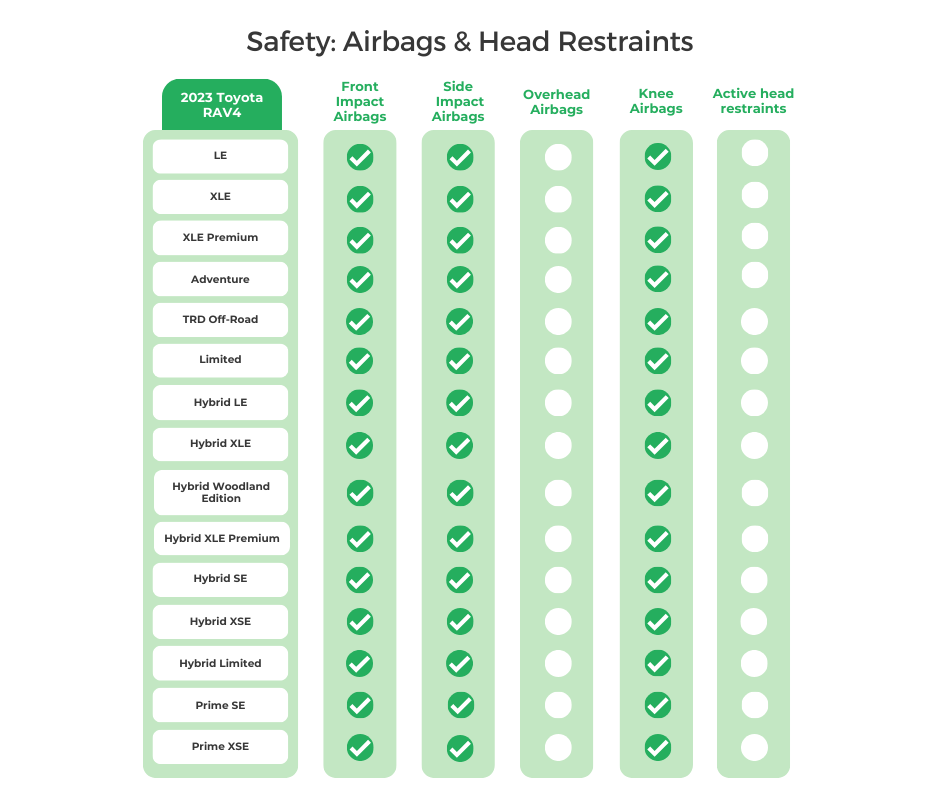
Semi-Autonomous Driving:
The promise of semi-autonomous driving is a hot topic in the automotive industry these days because who doesn’t want to be Will Smith in I, Robot and take a nap while their transportation pod hurtles down the highway on its own? Ok, we’re a WAYS off from that dream, but the associated technology continues to evolve.
Subaru calls its bundle of advanced driver-assistance systems (ADAS) EyeSight, while the RAV4 comes with Toyota Safety Sense. With these suites of tech, both crossovers come standard with continuous assistive and corrective steering, adaptive cruise control, and automated emergency braking as well as several braking system features.
As you can see in the table below, each automaker likes to give these systems their own names, which can be confusing, so we’ve created columns describing the associated function for clarity. Neither SUV offers a self-parking system and only the Outback can be fitted with reverse automatic braking, which will hit the brakes if you’re backing up and about to hit something.
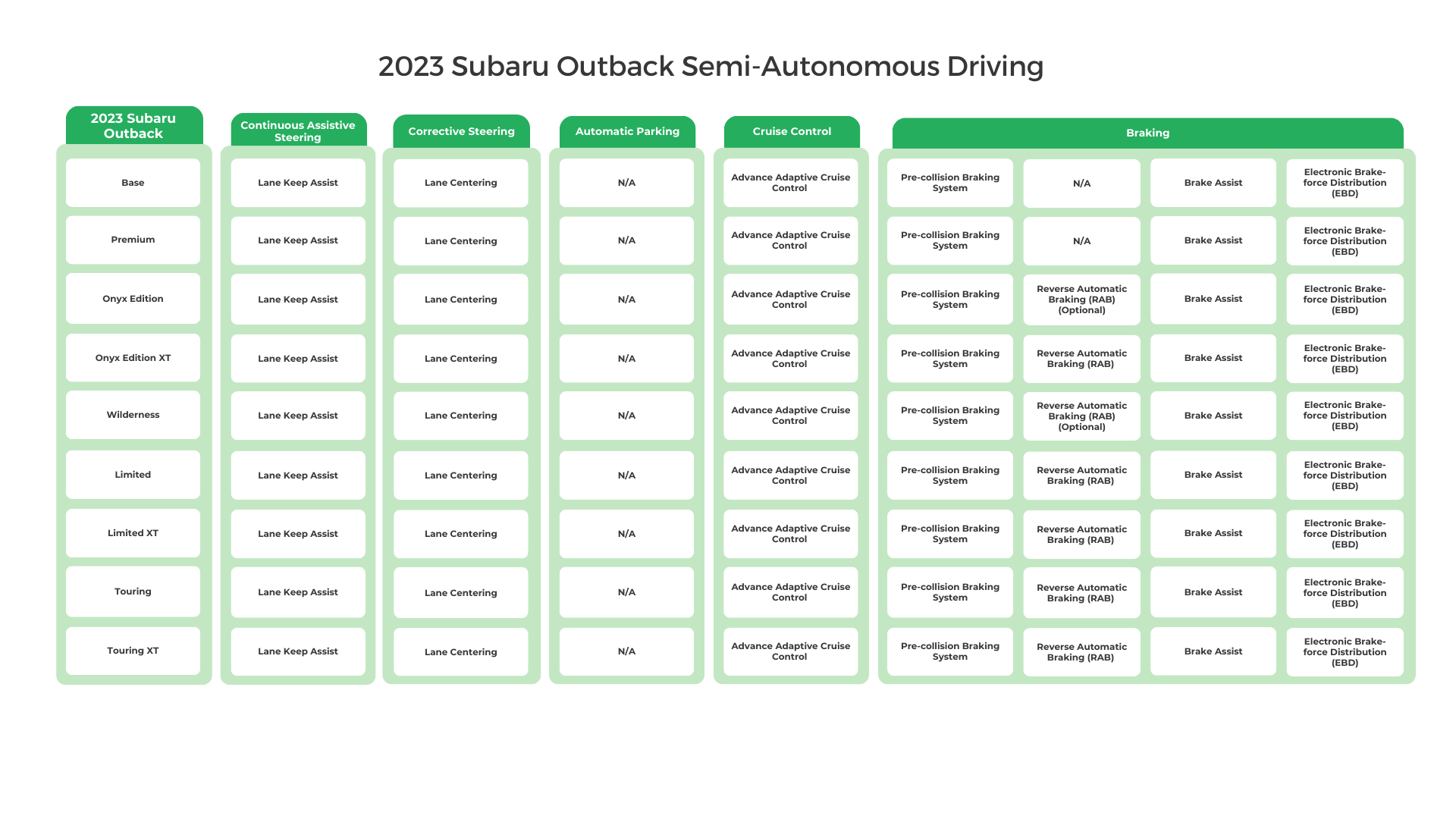
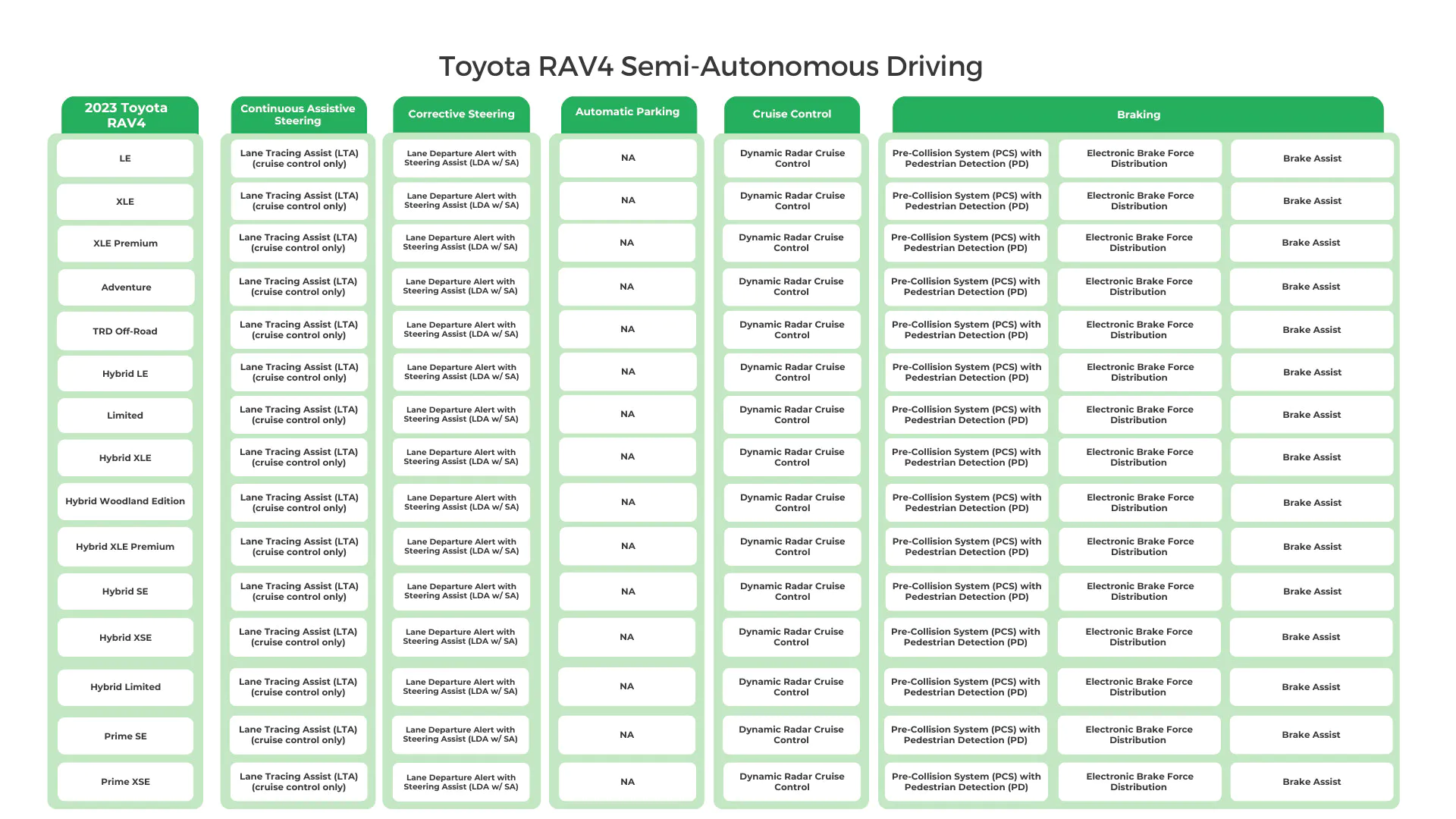
Driver Warning Systems & Telematics:
The ADAS party continues with lane departure warning and forward collision warning with pedestrian detection standard across both the 2023 Outback and RAV4 lineups. Neither model offers intersection turn assistance or safe exit assist, but a comprehensive telematics suite is widely available in both cases.
Blind-spot monitoring with rear cross-traffic alert becomes standard at the Outback Onyx Edition level and RAV4 XLE trim level. It’s a mixed bag from here with a rear occupant alert standard on the Subaru but unavailable on the Toyota, while the reverse is true for traffic sign recognition.
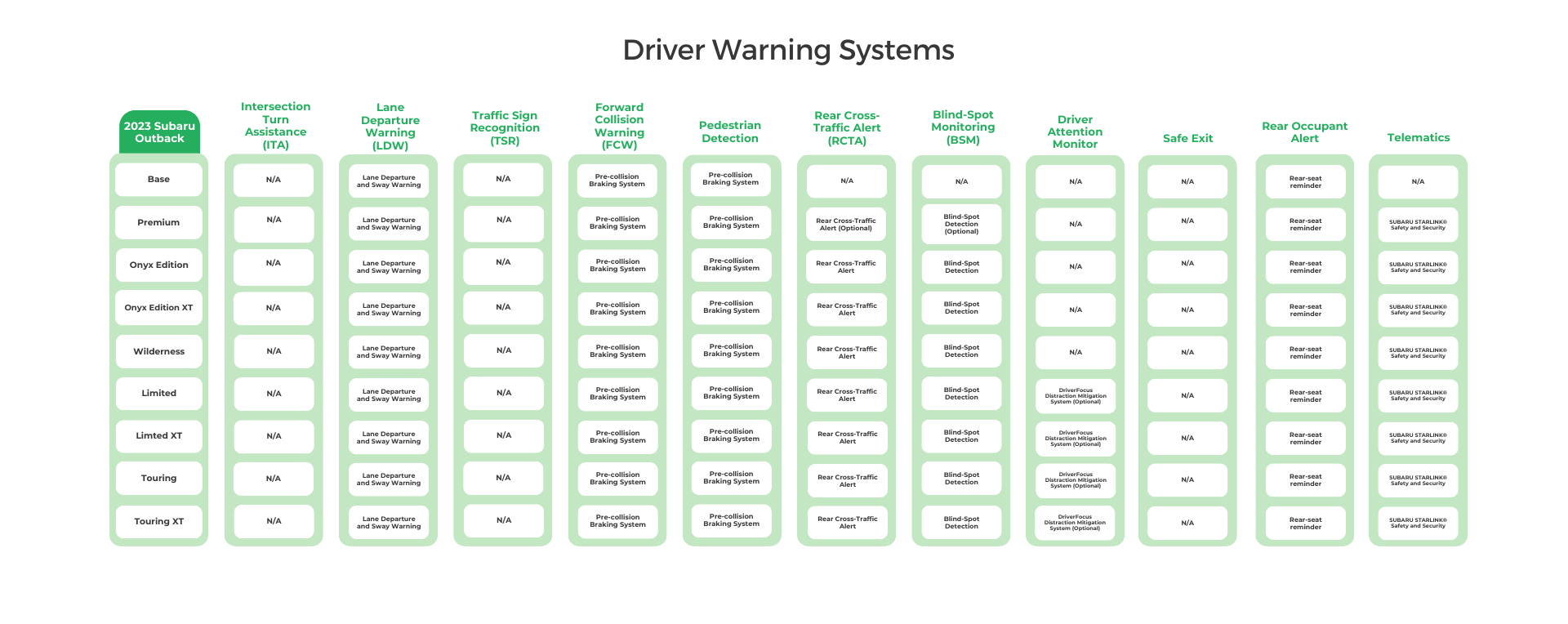
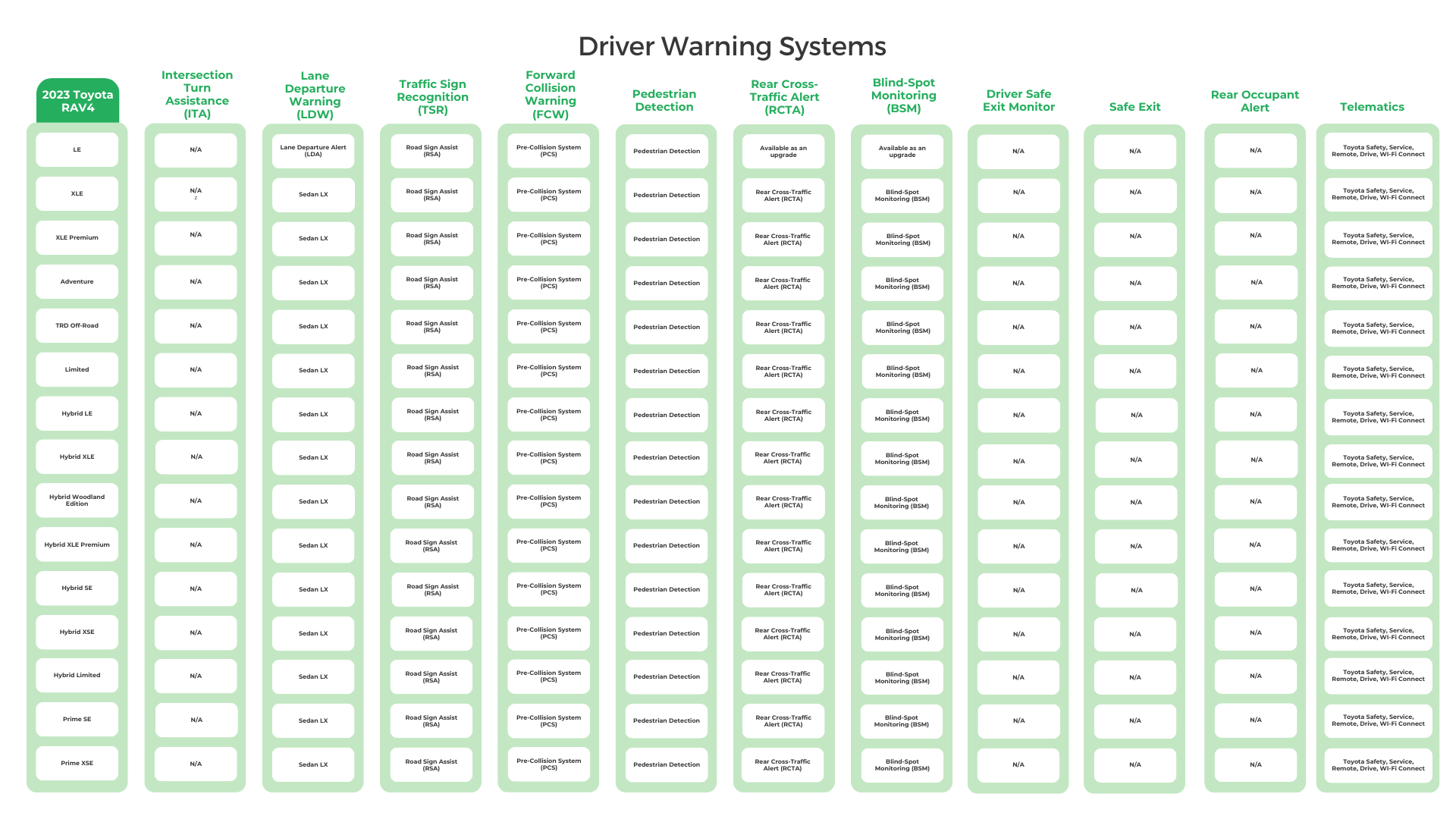
Road Visibility Features:
LED headlights are an increasingly common feature on modern vehicles that do wonders for road visibility, particularly at night. They are standard on the 2023 Subaru Outback and Toyota RAV4, but Subaru goes a step further by making them adaptive, meaning the lights swivel in concert with the steering wheel.
Both SUVs have automatic high beams and come with a backup camera, the latter of which has been federally mandated since 2018, but only the RAV4 offers a head-up display and rain-sensing wipers. Just like they sound, these high-tech wipers turn on and off and manage speed automatically.

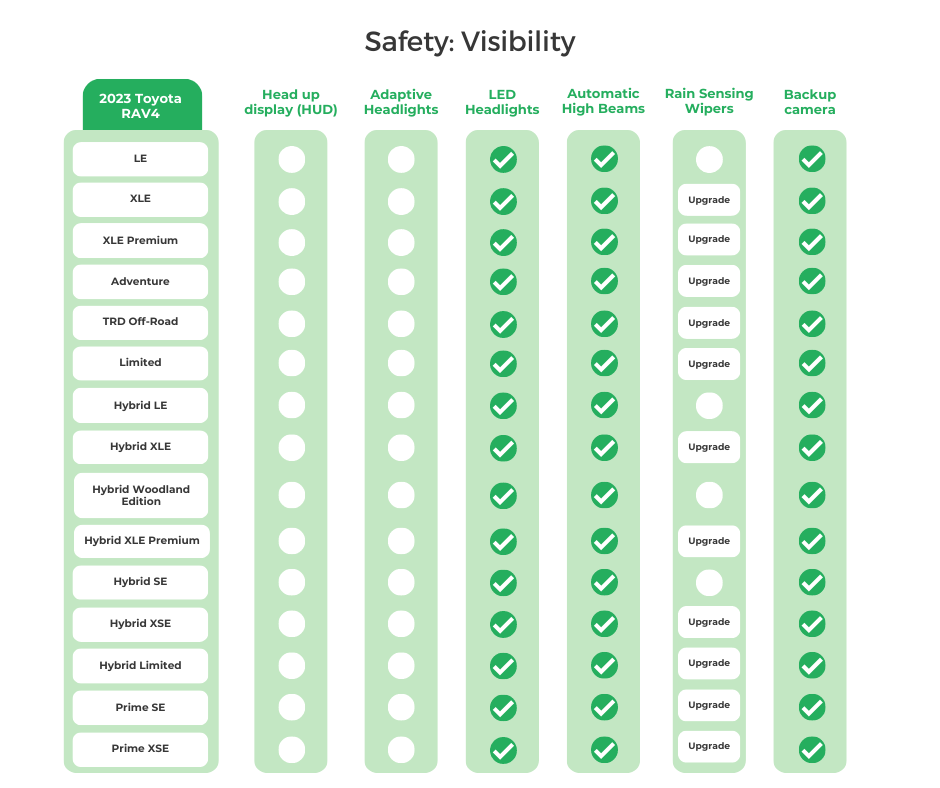
Interior:
Quick Take: If interior space is your priority, it’s the Subaru Outback hands-down – the widely standard heated front seats don’t hurt.
Interior Features:
Like the aforementioned LED headlights, Apple CarPlay and Android Auto have become must-have conveniences in modern vehicles and both the 2023 Outback and RAV4 come standard with these systems.
Heated front seats are arguably sought after, but not lineup standard on either model. However, they are included on every Outback except Base trim, versus more scattered availability on the RAV4, which is perhaps due to the Subaru’s popularity in cold climates.
Something you won’t find here is subscription-based heated seats. Part of a burgeoning “Features On Demand” industry that McKinsey says is set to take off, you only need to pay for the subscription when you want to warm your buns and not during, say, the height of the summer. Confused? You’re not alone as most consumers remain unfamiliar with the concept.

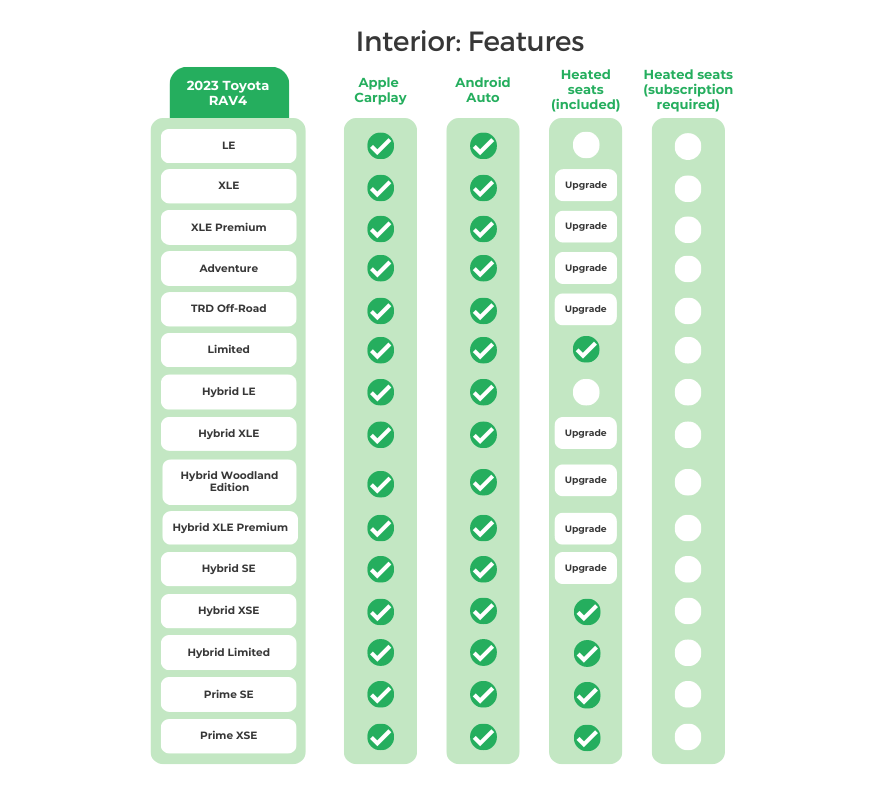
Interior Dimensions:
The 2023 Outback and RAV4 are both two-row crossovers with room for 5, or 4 comfortably, but that’s where the similarities end.
Aside from the extra inch of rear headroom in the RAV4, the Outback is bigger in legroom, shoulder room, and hip room – particularly the nearly 7 more inches in the back seat. All of which translates to 10 more cubic feet of overall passenger volume in the Subaru.
As for cargo space, the RAV4 offers 5 more cubic feet behind the second row than the Outback, but the Subaru maxes out at 76 cubic feet versus 70 in the Toyota. Choose wisely.
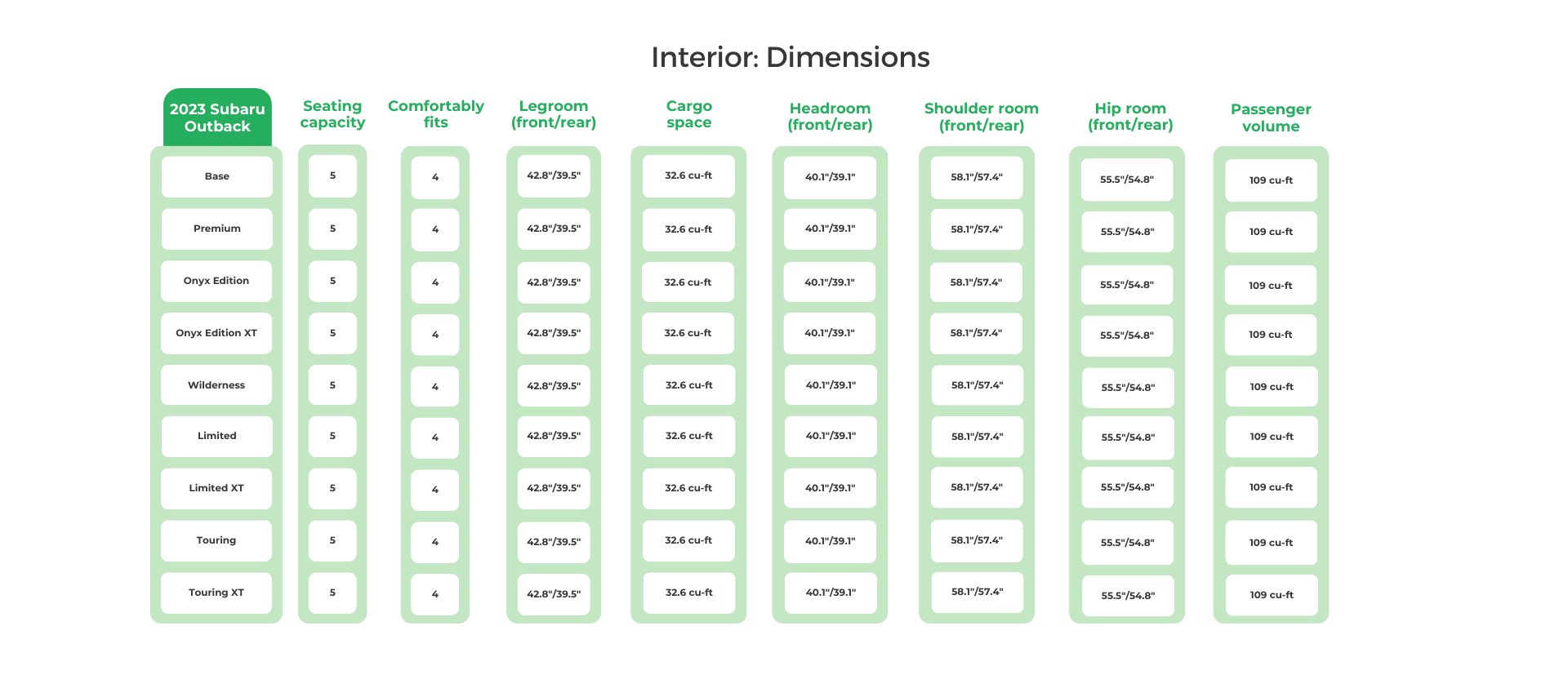

Exterior:
Quick Take: Larger and lower than the RAV4, the Outback enjoys sleeker wagon lines and offers more ground clearance.
Exterior Features:
You may not be looking to buy a new Subaru Outback or Toyota RAV4 for style points, but there are a handful of exterior features worth pointing out.
For example, you can still get steel wheels and hubcaps on your base RAV4. Over at Subaru, it’s an all-alloy affair. That being said, the Outback maxes out at 18” wheels versus 19s for the Toyota, which also offers sweet bronze rims.
As for the color palette, don’t expect anything too crazy here, but a wide array of blues, reds, and greens accompany the usual black, white, and silver options.
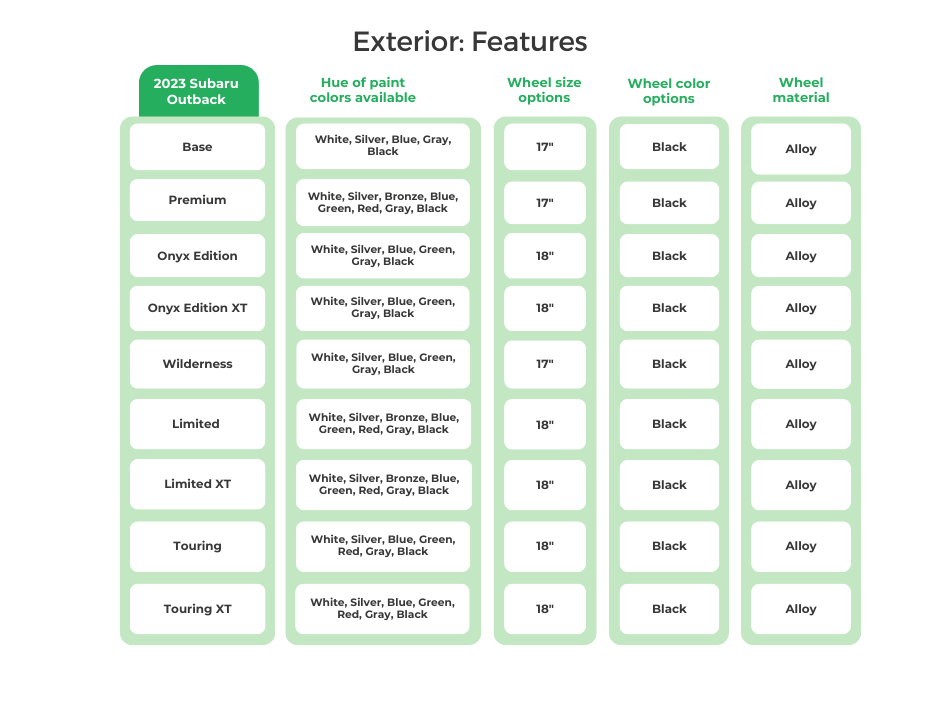
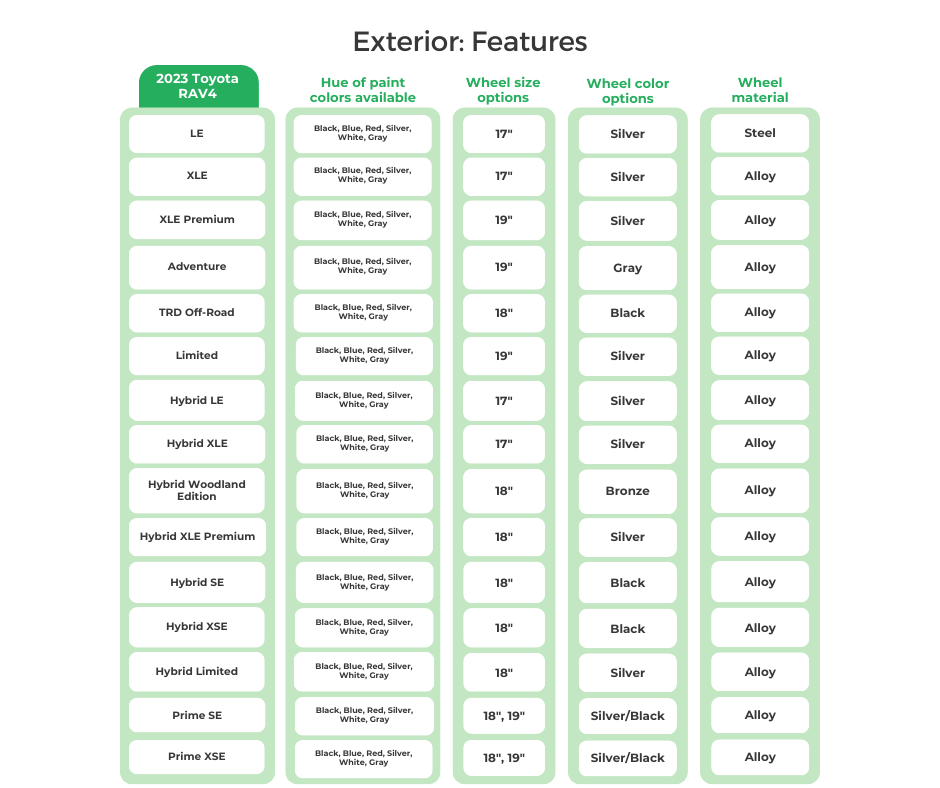
Exterior Dimensions:
Like inside, the Outback is bigger than the RAV4 outside in just about every metric. It’s 11” longer, 1” wider, and the off-road-ish Wilderness model has nearly 1 more inch of ground clearance than the RAV4 in TRD Off-Road spec.
You do get an extra inch of height in the Toyota, which does help in the headroom department as noted earlier. And though the RAV4 Primes are the only models to crack 4,000 pounds on the scales, they make up for it with excellent overall efficiency.
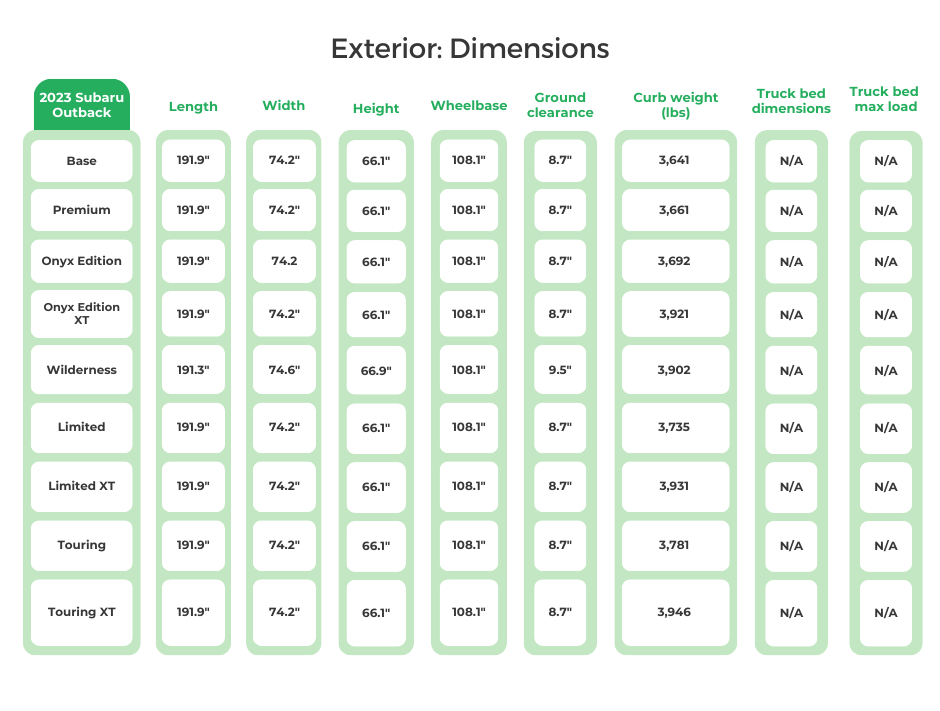
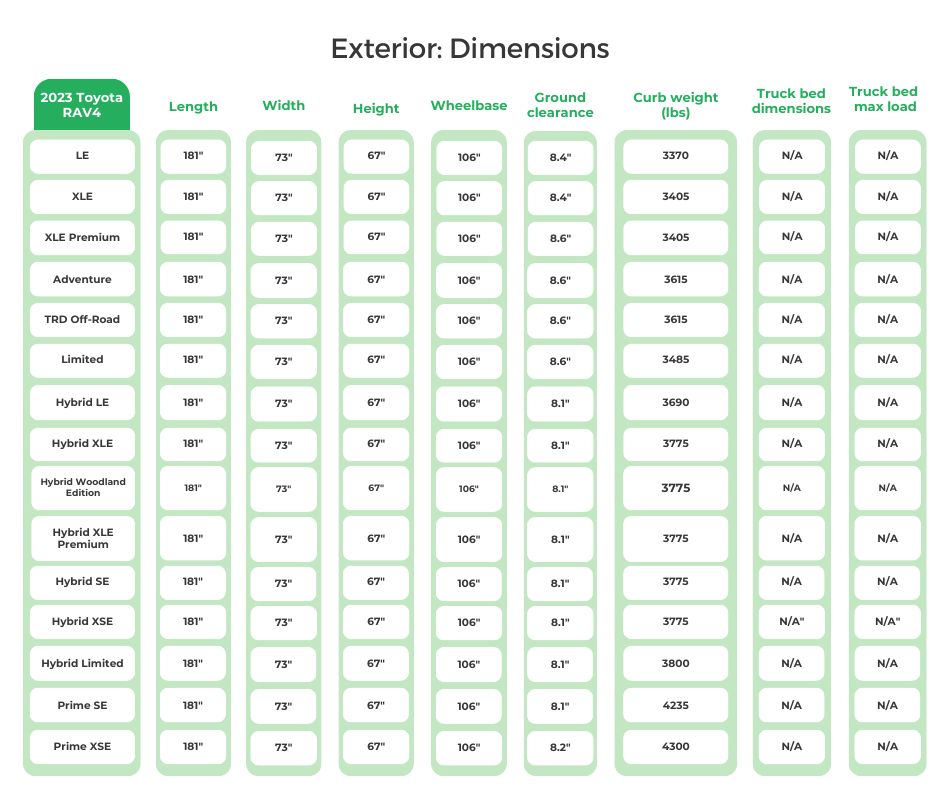
Warranty:
Quick Take: Basic and powertrain warranty terms are identical between the Outback and RAV4, but only Toyota includes complimentary maintenance for 2 years.
Both the 2023 Outback and RAV4 have a 3-year/36,000-mile basic warranty and a 5-year/60,000-mile warranty. The hybrid battery packs on RAV4s have a separate 10-year/120,000-mile warranty.
Subaru offers an extra year of roadside assistance with its warranty, but Toyota includes 2 years of complimentary maintenance, something Subaru doesn’t offer at all.
So far, the recall count for these crossovers is small with 2 for the Outback and 1 for the RAV4.
| 2023 Subaru Outback Factory Warranty Coverage: | 2023 Toyota RAV4 Factory Warranty Coverage: | |
| Basic warranty: | 36 months/36,000 miles | 36 Months/36,000 Miles |
| Powertrain warranty: | 60 months/ 60,000 miles | 60 Months/60,000 Miles |
| Corrosion perforation warranty: | 60 months/Unlimited miles | 60 Months |
| Air conditioning warranty: | 36 months/36,000 miles | 12 Months/12,000 Miles |
| Battery warranty: | 36 months/36,000 miles | 120 months/150,000 miles (Hybrid Battery). Reduction in traction battery capacity for Plug-in Hybrid trims is not covered. |
| Emissions warranty: | 36 months/36,000 miles (Federal), 36 months/50,000 miles (California) | Federal: 36 month/36,000 miles (defect), 24 months/24,000 miles (performance)California: 36 months/50,000 miles (performance) |
| Roadside assistance coverage: | 36 months/36,000 miles | 24 months/25,000 miles |
| Total unique recalls: | 2 (recall no. 23V755000 & 23V647000 | 1 (recall no. 23V485000) |
Methodology
- Compare two vehicles, Subaru Outback and the Toyota RAV4, and provide a comprehensive analysis.
- Gather relevant information and data on both vehicles from reliable sources, such as manufacturer specifications, expert reviews, customer feedback, industry reports, and data sources like manufacturer websites, FIXD App, Kelley Blue Book, FuelEconomy.gov, and NHTSA.
- Collect data on various aspects, including performance, safety features, fuel efficiency, maintenance costs, reliability, owner satisfaction, and market value.
- Identify the key criteria that will be used to evaluate and compare the two vehicles.
- Ensure the criteria cover both objective factors (such as performance metrics, safety ratings, and fuel efficiency) and subjective factors (such as owner satisfaction, comfort, and features).
- Assess the performance of both vehicles based on factors such as acceleration, handling, braking, and overall driving experience.
- Compare engine options, horsepower, torque, transmission options, and any unique performance features.
- Examine the safety features and ratings of both vehicles.
- Evaluate crash test ratings, advanced driver assistance systems (ADAS), active and passive safety features, and any notable recalls or known issues related to safety.
- Consider both NHTSA safety ratings and IIHS awards for a comprehensive safety assessment.
- Analyze the fuel economy of both vehicles based on EPA mileage estimates.
- Compare their MPG ratings, average full-tank range, and any significant differences in fuel efficiency.
- Assess the average annual maintenance and repair costs for both vehicles.
- Consider data from surveyed owners and other reliable sources, such as FIXD App owner surveys, to determine the overall cost of ownership over time.
- Evaluate the reliability of both vehicles based on owner reports, FIXD App data, and any known issues or recalls.
- Consider factors such as engine reliability, common problems by model year, long-term durability, and owner reliability scores gathered from surveys.
- Consider owner satisfaction by gathering information from forums, online communities (Reddit: r/whatcarshouldIbuy), customer reviews, and owner reliability scores.
- Summarize key factors that owners appreciate and any common complaints or drawbacks mentioned by owners.
- Compare the features and technologies offered by both vehicles.
- Highlight any notable differences in terms of infotainment systems, connectivity options, driver assistance features, interior quality, and available upgrades.
- Assess the market value and depreciation of both vehicles.
- Compare average prices, resale value, and how the vehicles hold their value over time.
- Consider average private-seller valuations from Kelley Blue Book (KBB) for a comprehensive assessment.
- Summarize the findings of the comparison, highlighting the positives and negatives of each vehicle.
- Provide a fair and balanced recommendation based on the comparison, considering factors such as budget, personal preferences, specific needs of the buyer, and the comprehensive analysis conducted.
Sources:
- Fuel Economy: Mileage-per-gallon estimates according to the EPA MPG on Fueleconomy.gov.
- Annual Maintenance/Repairs: Upkeep expenses as published by Edmunds.com.
- Safety Ratings: Crash test data collected and reported by NHTSA. We average all ratings for each year to come up with a simplified, average safety score. This makes it easier to look at on a graph. We also collected IIHS Awards for this article.
- Vehicle Features: Most or all information gathered on vehicle features were from the manufacturer websites, in this case Subaru.com and Toyota.com

Niel Stender grew up doing replacement work on his old Cherokee and sweet Mitsubishi Starion, which led to a degree in mechanical engineering and a job at Ford as a vehicle dynamics engineer. His writing infuses that automotive background with sales and marketing experience. Writing about cars for close to a decade now, he enjoys digging into some of the more technical mechanical systems under the hood and throughout a vehicle.

